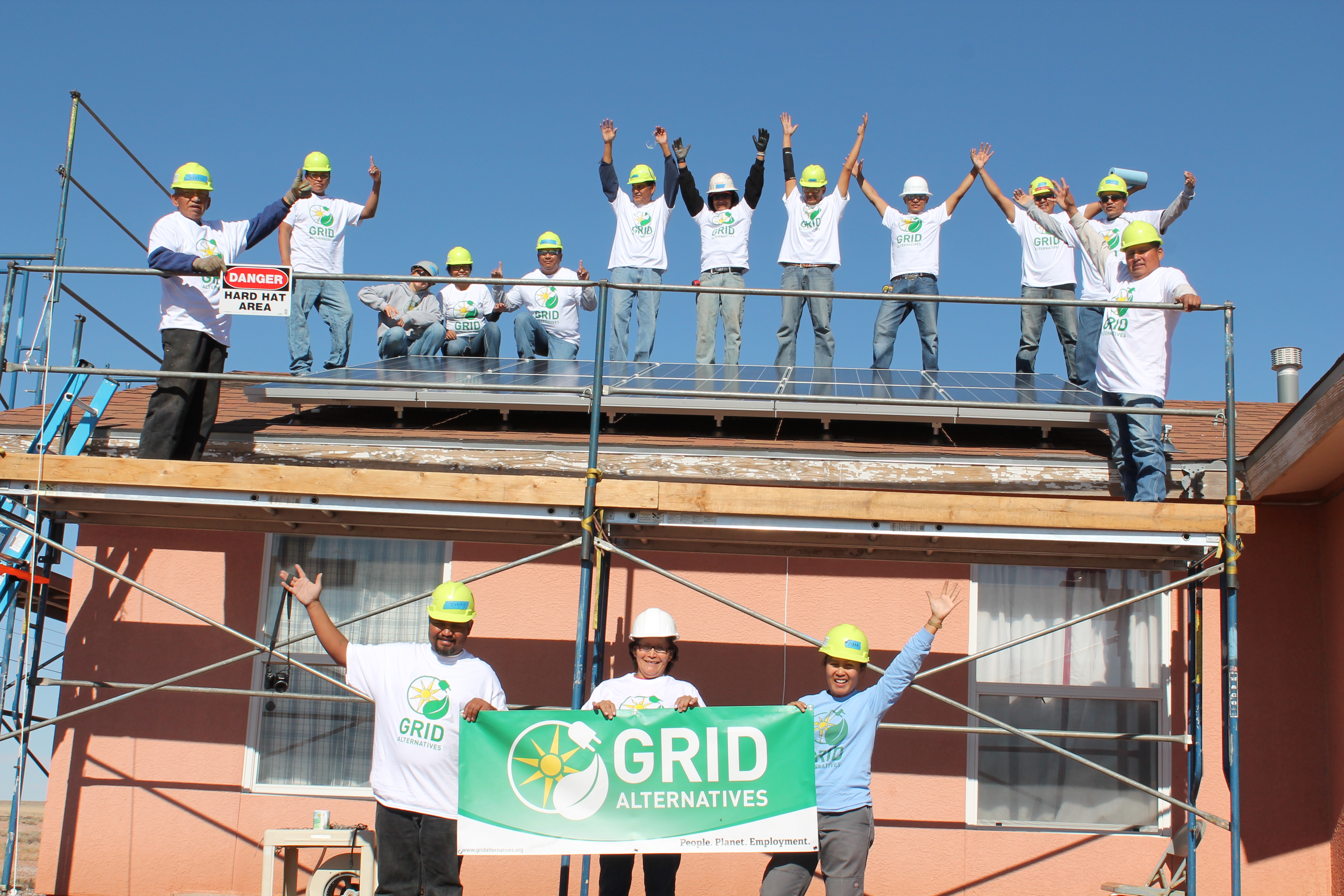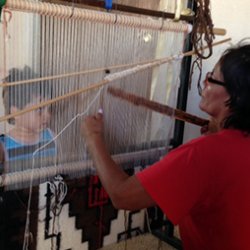Between the four sacred mountains of the Navajo Nation (Diné Bikeyah), the land and sky stretch vast and wild. Dook'o'oosłííd’ (the mountain that reflects), otherwise known as the San Francisco Peaks, rises from the landscape about an hour’s drive west of Bird Springs (Tsidi To'ii ) Chapter House in Northeastern Arizona. It is said that the holy people adorned the mountain in abalone shell and fastened it to the earth with a sunbeam to create understanding of social unity and life. Today, that solidarity is reflected in the community members of Bird Springs, Leupp and Tolani Lake, who continue to reside on their ancestral lands, care for their elders, youth and communities, and who envision a future woven with resilience, tradition and opportunity that inspires people on the path of Hózhóogo naasháa doo – “walking in beauty.”
In mid-November, GRID Alternatives’ Tribal Program staff, in partnership with the three communities came together for an inaugural installation of a 2.6kW grid-tied solar photovoltaic system on the home of Lena William in Bird Springs, AZ. Lena is a Navajo rug weaver from a long line of renowned rug weavers, and her face lights up as she shares how to card, spin and weave. Inside her home, the soft Churro wool is in bundles ready to be hand spun and woven. Lena's fingers move rhythmically across the loom. It is an art she learned as a child, rooted in over three centuries of co-evolution between the Diné (Navajo) people and the high desert of the Colorado Plateau. Oral history passed from one generation to the next describes an inextricable link between the universe, nature and the Diné (Navajo). It is in this way that culture is woven through time.
Lena says that she rarely has time to weave anymore and that she hasn't traveled to market in a couple of years. Economic opportunity is scarce on the Navajo Nation (Diné Bikeyah) with unemployment estimated at 42%. Lena's daughter, Lynelle, like many skilled and driven Navajo youth, commutes to Winslow, AZ, a border town outside the reservation for work. She is also a full-time student at Northland Pioneer College. When she graduates, she will be among the less than 10 percent of Navajo youth with a college degree. Lena stays home to care for her grandchildren and mother, who is 83 years old and lives further south down the dry washboard road. Over time it seems Lena has transformed from weaver to the very spindle that creates the warp strings and yarn, connecting her children and grandchildren to their great-grandmother and Navajo homeland (Dinetah).
Outside a sheep skin dries in the desert wind and sun. The meat was made into mutton stew, along with warm fry bread, to feed Navajo tribal volunteers and staff from GRID Alternatives for a lunch gathering on the second day of the installation. Many folks came together for this build, including the Navajo Tribal Utility Authority (NTUA), which provides electricity, water, natural gas and wastewater services to approximately 34,000 homes within the reservation. The Bird Springs Chapter House graciously hosted a half-day classroom training in solar electricity in advance of the two-day installation.
 Once complete, the installation was the first residential grid-tied solar system ever inspected by NTUA. The utility does not have a net metering policy allowing customers to sell back to the grid, so the family’s savings will be limited to the solar energy they actually use. But still, Lena is excited to be part of this pilot project and grateful for the much needed relief it will bring to her family.
Once complete, the installation was the first residential grid-tied solar system ever inspected by NTUA. The utility does not have a net metering policy allowing customers to sell back to the grid, so the family’s savings will be limited to the solar energy they actually use. But still, Lena is excited to be part of this pilot project and grateful for the much needed relief it will bring to her family.
“It's a hardship.” Lena explains, “My contract as a teacher was terminated a year ago. My daughter has to pay for gas to commute three hours a day. Most of what is left goes to our utility bills.”
The solar system at her home will not only help offset some of her utility bills, it was also a great way for the community to come together to introduce a new technology that resonates with her and her community. “Getting energy from the sun is the natural way and is better than using up water and burning coal,” said Lena.
The Navajo economy, once driven by artisans, traders, wool and sheep, is now largely dependent on non-renewable energy development such as coal mining and electricity generation. But at the local level, chapters are collaborating and laying the foundation for community based sustainable development.
Bird Springs, Leupp and Tolani Lake have been working together to integrate more traditional forms of economic development with newer renewable technologies. The communities recently embarked on agriculture and farming projects sustained with a 17 kW solar water pump as well as ground mount PV arrays at the Tolani Lake Chapter House. The chapters have also supported the installation of off-grid solar electric systems throughout their communities. Load and battery maintenance on these systems have been challenging, but the communities continue to be invested in helping families without access to reliable electricity and providing low-cost clean renewable energy to families.
The desire to learn about solar PV installations was on full display at the installation at Lena’s home. In spite of Veteran’s Day celebrations taking place, over ten participants from all three chapters took part and were enthusiastic, skilled and worked effortlessly as a team. As with many workers on the Navajo Nation, employment is often intermittent and skilled laborers have a number of valuable construction skills in various fields. Myron Lee, a concrete worker from Tolani Lake, arrived each day eager to learn. "It was real good knowledge for me to learn a real good trade.” He said. “I like the way we work together as a team to benefit people that are going to use this. Maybe I'll work as a technician or put one on my house."
Tyrone Thompson manages the garden at nearby Leupp Family Farms and helps with the food program at the STAR school, an off-grid K-8 school just over the border toward Flagstaff. He has assisted on solar PV installs in his community, and was eager to learn more and develop his PV skillset. “I’m real excited that GRID is enabling our young people to work with solar providing a free training and a PV system for a low-income single grandparent,” he said. “This install has introduced me to the next level of solar and opened up new doors to employment, education and opportunity.”
“I’m also grateful for renewable resources that are good to Mother Earth,” he said.
Article by Kristin Lester, an AmeriCorps VISTA serving a year with GRID's Tribal Program as a SolarCorps fellow. Click here to see photos from the install!

